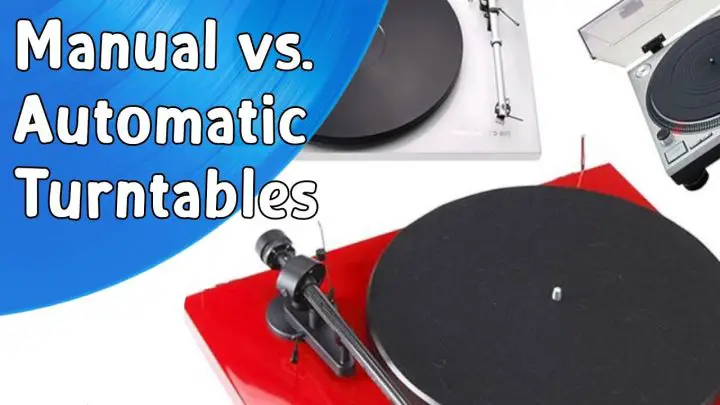Are you left ever pondering the precise differences between a manual vs automatic turntable? Are you on the precipice of buying your first proper turntable and want to make the right investment? Is this perhaps the first turntable you have bought that is not inherited from a family member, an investment for life that you want to make sure you do right?
Then welcome, for today we will be exploring the key differences between manual turntables and automatic turntables.
There is in fact one main difference, that the former requires the user to place the needle onto the record while the latter does not, though I seek to exhibit today that even such a seemingly small difference as this can have massive consequences in terms of the overall quality of the sound produced.

Table of Contents
- What’s the Difference Between a Manual vs Automatic Turntable?
- Why Are All Turntables Not Automatic?
- Which Is Right for You?
- Final Tones
- FAQs Manual vs Automatic Turntable
What’s the Difference Between a Manual vs Automatic Turntable?
The central difference that sets manual turntables and automatic turntables into this binary is precisely what gives them their namesakes. Sometimes, it may be hard to distinguish between the best automatic turntable and the best manual turntable.
An automatic turntable will be labeled so because its inherent mechanics are designed to be automatic and of the utmost convenience for the user. These inner mechanics will link the platter and the tonearm, causing them to move as one.

At the push of the corresponding button, the arm will ascend and then lower itself at the start of the record (a fully automatic turntable will feature an option to change the disc to a 7 inch or 12 inch record – something that semi automatic turntables are less likely to feature).
Related Read: Vinyl Record Size Chart
All automatic turntables will, regardless of whether it is a semi automatic turntable, will, however, lift the tonearm automatically at the end of each side and return it to its resting position.
A manual turntable, by contrast, forces the user to take full control, meaning that they will need to manually cue up the tonearm onto the edge of the record and then lower it onto the surface of the record oneself.
This is not all, for the tonearm will then need to be removed from the record once the disc has finished spinning, whether that be to flip the disc, play something else entirely, or simply to stop it spinning in the first place.
This might not be a big deal for some. Manual and automatic turntables play music and they have the capacity to do it well, especially in the case of a good quality manual turntable or automatic turntable, what gives? For some, however, this is a big gripe and one that sees no end of contention, leading many to ask
Why Are All Turntables Not Automatic?
It is a good question – logical, sensical.
Though you can depend upon a manual or automatic turntable to do the job of spinning discs and projecting the sound forth, the latter offers a very clear advantage over the former, bringing a whole host of perks relating to convenience to the table.
In this way, automatic turntables tend to be the domain of the beginner or intermediate collector, one that enjoys the medium but is not ready to take it all the way – or at least that is how an audiophile might see it.
It is an opinion that runs deep within the vinyl community, one that is very much inspired by and bounces off of relative elitism within such a select and niche area of the popular cultural landscape.
In all fairness, an audiophile would argue that fully automatic turntables are compromising, for they purportedly introduce mechanical noise and interference.
The fact that tonearm and the turntable platter are inextricably linked via mechanical modes means that the points of connection like the cogs, gears, and springs can create an undesirable din, which on its own or resonated through the stylus can cause a ruckus.
Thus, an audiophile will render claims against an automatic turntable that pertain to sound quality.
This is a sentiment echoed in the design limitations of an automatic turntable, whose inner body will have to be hollow in order to accommodate the aforementioned mechanisms that connect the movements of the tonearm and the turntable platter.
Audiophiles will then shout aloud that such a hollow body can do nothing for the resonance of one’s record collection, that a fully automatic table will simply do an injustice to any vinyl records that it meets.
Hence, why most serious record collectors tend to eschew the notion of using an automatic turntable. Still, it can be hard to know unless sent through a proper amplifier for turntable.
Which Is Right for You?
And the answer will depend very much on what you are looking for in a record player / turntable.
If you are a casual record collector who is looking for the vinyl experience but is not willing to compromise on convenience, then an automatic turntable is definitely the ticket for you. There are plenty of mid to high-end models that can do a brilliant job of translating records into sweet and mellifluous sounds, making them an example of one of the best record player for beginners.
Those looking for the best possible performance from their record collection would do best, as many audiophiles would suggest, to invest in a solid and reliable manual turntable.
Manual turntables are easier to upgrade, amongst a whole host of other things. Changing the cartridge is more likely to be possible on a manual turntable, where each of the elements is designed to be replaceable.
A vintage manual turntable, or a modern manual turntable in the mid to high price range, is going to be a turntable for life, and so everything should be replaceable or repairable.
All too often, you will see with manual turntables that they are more or less disposable, with many of the elements all tacked on together, made in an era where the aim was to encourage a customer to buy another one instead of repairing the one they already owned, for companies quickly realized this was to their financial advantage.
There are a whole host of manufacturers that do care now, though, and this second vinyl era promises to be the best and most interesting yet.
Final Tones
So, there you have it! Hopefully your various curiosities about the nature of the manual and automatic turntables have been satiated and you are feeling more knowledgeable on the subject as a result.
Hopefully, too, you can now see that even such a seemingly small difference as the one that separates a manual vs automatic turntable can have considerable and magnanimous consequences in terms of the tonal character of the sound produced.
Though evidence seems to suggest that a manual turntable does indeed sound better, this is not to write off the automatic turntable by any means, for it can do an ample (and sometimes even exemplary) job of projecting forth the desired sound, and they will often be far more convenient for some users.
An audiophile, however, would suggest that to use a manual turntable regularly is to live and experience the full vinyl experience, so you must make up your own minds which type of turntable suits your needs and desires best.
FAQs Manual vs Automatic Turntable
Is automatic or manual turntable better?
Neither is inherently better and which you decide upon will depend on your individual needs and wants from the turntable in question. If you are a casual record collector who is looking for the vinyl experience but is not willing to compromise on convenience, then an automatic turntable is definitely the ticket for you. There are plenty of mid to high end models that can do a brilliant job of translating records into sweet and mellifluous sounds. Those looking for the best possible performance from their record collection would do best, as many audiophiles would suggest, to invest in a solid and reliable manual turntable.
Do manual turntables sound better?
This is a matter of much debate, but many an audiophile would contend and agree that manual turntables do sound better, even if only somewhat. The fact that, in an automatic turntable, the tonearm and the turntable platter are inextricably linked via mechanical modes means that the points of connection like the cogs, gears, and springs can create an undesirable din, which on its own or resonated through the stylus can cause a ruckus. This is a sentiment echoed in the design limitations of an automatic turntable, whose inner body will have to be hollow in order to accommodate the aforementioned mechanisms that connect the movements of the tonearm and the turntable platter.
What is the difference between an automatic and a manual turntable?
The main difference between an automatic turntable and a manual turntable is that which gives them their names. An automatic turntable will be labeled so because its inherent mechanics are designed to be automatic and of the utmost convenience for the user. These inner mechanics will link the platter and the tonearm, causing them to move as one. A manual turntable, by contrast, forces the user to take full control, meaning that they will need to manually cue up the tonearm onto the edge of the record and then lower it onto the surface of the record oneself.





